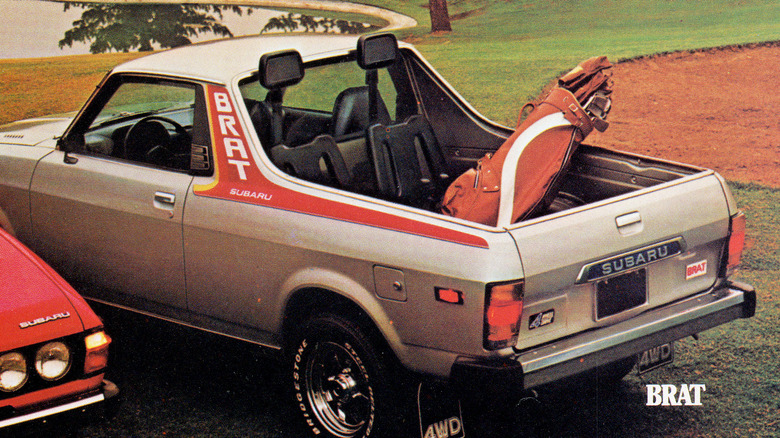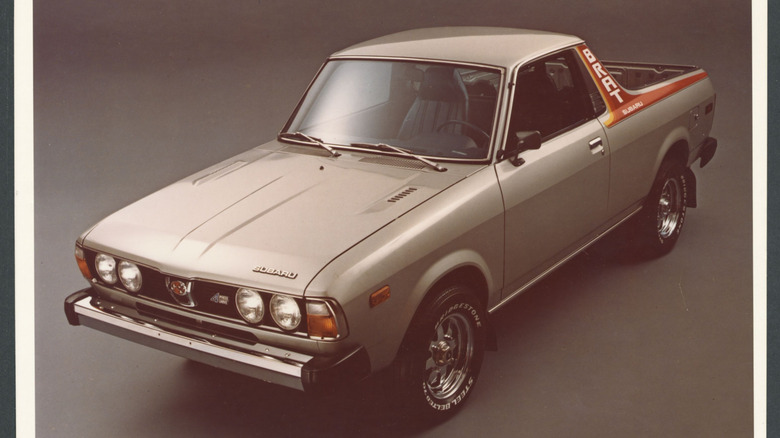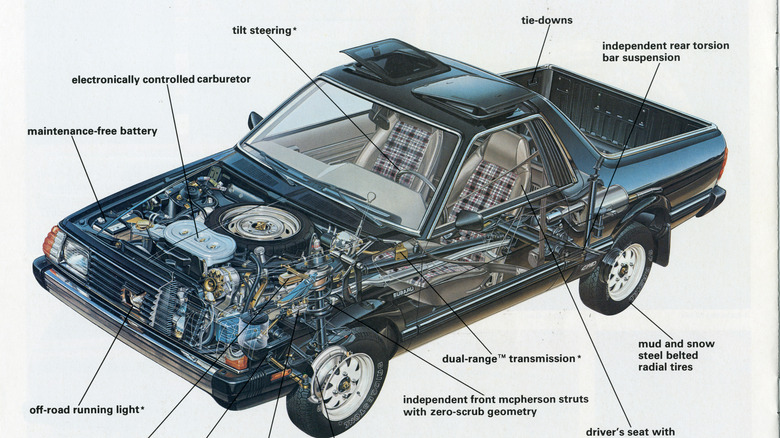Why Did The Subaru BRAT Have Seats In The Truck Bed?
The Subaru BRAT was rare not just in its design, but because it was arguably the most popular "ute" in the United States aside from the Chevy El Camino and Ford Ranchero. The BRAT still turns heads at modern car shows for its rarity, distinctive styling, and sometimes factory-equipped rear-facing seats in the truck bed.
The model name BRAT is an acronym for Bi-Drive Recreational All-Terrain Transporter; Subaru opted for "BRAT" over the strictly correct but much less euphonious "BDRATT." It was effectively a Subaru Leone wagon with a pickup bed, and was sold from 1978 to 1987 in the United States and through 1994 in other markets. The BRAT was badged as the Brumby, Shifter, and Targa in various locales, though Subaru thought there wasn't demand for it under any name in its home market of Japan. The Bi-Drive and All-Terrain tags come from the BRAT's ability to shift between 2WD and 4WD via a switch inside the cabin. At first, the only available engine was a 67-horsepower, 1.6-liter four-cylinder boxer, but a 1981 facelift saw the engine stroked out to 1.8 liters and 73 horses. Australian buyers could get a turbocharged version that made 95 horsepower.
As for the bed seats, they were part of Subaru's business strategy. They were installed as a way to avoid the Chicken Tax, a 25% tariff on foreign-built pickup trucks imposed by President Lyndon B. Johnson in 1963 in response to European taxes on U.S. poultry imports. To avoid the tariff, Subaru installed removable jump seats in the bed along with carpeting and seatbelts and called the BRAT a "passenger car" despite its form factor. It was a clever move to avoid the BRAT being classified as a light truck, despite its truck-like design with a two-seat cab and bed behind.
why did Subaru make the BRAT?
The BRAT has an interesting origin story with the seats being just the tip of the iceberg: the model was a child of the 1970s oil crisis. The BRAT came along with the subsequent wave of compact imports, with gas-guzzling V8s falling by the wayside as fuel prices skyrocketed and corporate average fuel economy standards went into place. These developments paved the way for the mini-truck, which capitalized on the popularity of models like the Ranchero and El Camino. These small, lightweight pickups dated back to the '50s in the U.S. and were based on car chassis, making them nimble, safe, and fuel-efficient. Mazda, Toyota, Ford, and Chevrolet all tried their hand at making mini-trucks; Subaru entered the game comparatively late, but not before doing their homework on the Chicken Tax.
The tax effectively squelched the growing popularity of mini-trucks in the mid to late 1960s, pricing these vehicles beyond what customers were willing to pay for a light-duty truck. The tariff is actually still in place today thanks to lobbying by American automakers, and still impacts the market. The 60-plus year old Chicken Tax is one big reason why domestic pickups still outsell Japanese-made ones in the U.S. while the reverse is true for stateside compact car and sedan sales.The BRAT entered the American market at the ideal moment, just as buyers were beginning to truly embrace Japanese imports. The model merged the Japanese formula for reliable and efficient motoring with light truck utility and a healthy dose of fun factor. Unfortunately, sales were not great, and Subaru discontinued the BRAT after 1987.
The BRAT had some other strange features
The rear-facing seats — which Subaru labeled in brochures as "fun seats" — helped the BRAT avoid the worst of the Chicken Tax. In the end, it was still subjected to a 2.5% tariff imposed on Japanese passenger cars, raising the base price for a 1982 BRAT GL to $7,613 (about $25,500 today). But Subaru didn't stop with the seats, and loaded the BRAT with other eccentricities like a factory T-top, which Subaru called the "Halo-Twin Roof." The spare tire was mounted flat in the engine bay, perched horizontally between the air cleaner housing and firewall. The BRAT also featured an adjustable front and rear suspension, and the dashboard in later BRATs was contemporary 1980s sports-car chic with a mix of analog and digital elements.
Subaru actually dropped the rear seats late in the BRAT's production run, by which point many customers had adopted the habit of removing the bed carpeting due to rust issues. The seats, belts, and mounting hardware were also easily pulled, so it's difficult to find a BRAT with original intact carpet or seats today. Despite its rugged looks, the BRAT wasn't particularly adept off-road; it was made for style and didn't have the sure-footedness of its successor the Baja. Many people didn't buy the BRAT for use as a utility or adventure vehicle, but because it looked cool and was somewhat practical. It boasted such a distinct appearance that it earned a cult following and some attention from Hollywood.The BRAT was featured in "Napoleon Dynamite" and on episodes of "Knight Rider," "The A-Team," and "Miami Vice." Ronald and Nancy Reagan owned a red 1978 BRAT until they sold their Rancho del Cielo (Sky Ranch) in 1998, and the odd little ute remains among the weirdest Subarus ever brought to market.


